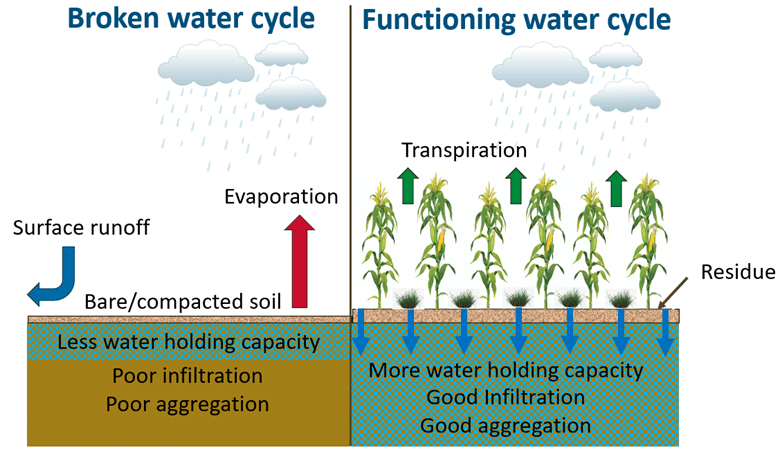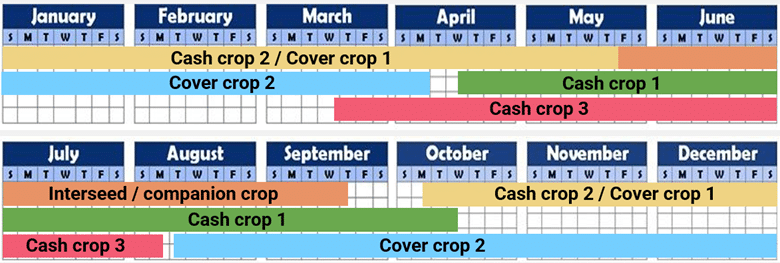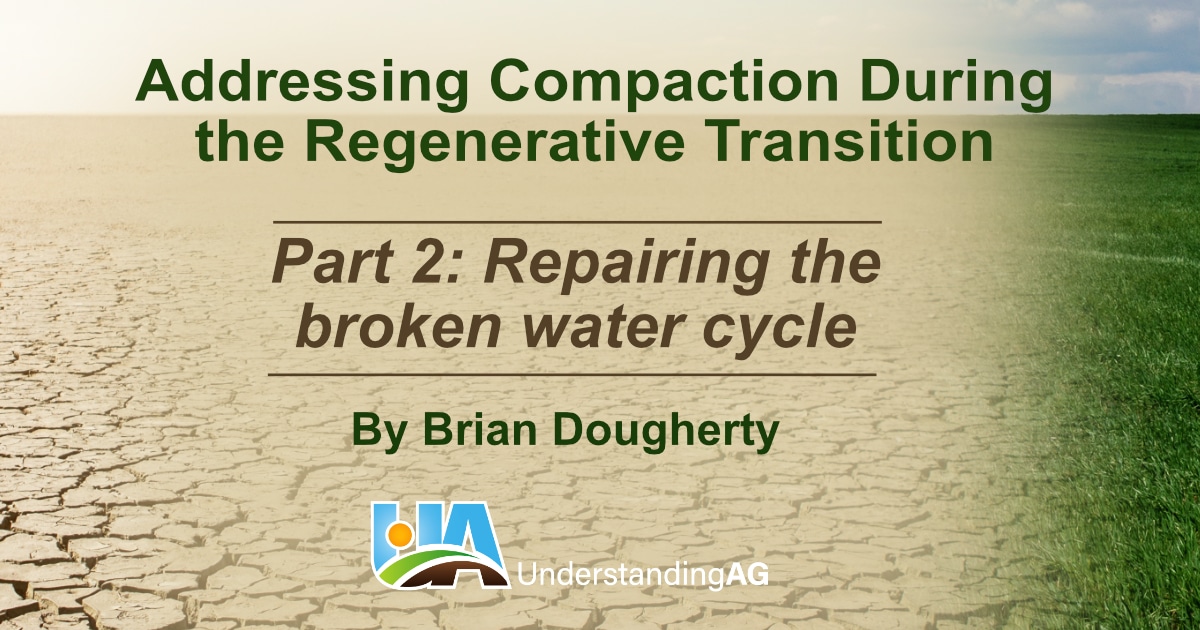In part one of this series, we reviewed the fundamental role that biological glues and soil aggregates play in creating healthy, strong soil that resists compaction. Given the importance of living roots that drive aggregate formation, how can we use that to our advantage to remediate and prevent compaction?
Living roots not only build aggregates, but they also help repair the water cycle in our fields. Poorly-drained and excessively-wet fields are particularly vulnerable to compaction. Compaction from equipment traffic is most severe when soil moisture is at or near field capacity, meaning the soil pore space is almost completely filled with water. Increasing soil porosity, adding organic matter, and getting water to infiltrate faster and deeper into the soil profile will all help prevent compaction and improve trafficability. All of these require well-aggregated soil and a living root. The better your water cycle functions, the easier it will be to complete fieldwork in a timely manner without damaging the soil.

Compaction will be more severe and more frequent in fields with a broken water cycle. It is almost impossible to prevent or remediate compaction successfully if the water cycle is not functioning well. You will just keep experiencing the same symptoms – surface crusting, ruts, wet spots, stunted growth, lost yield, and many others – until you address the underlying cause of the problem, which is poor aggregate formation and the lack of living roots.
Tillage can mask symptoms temporarily, but it will not fix the problem. Research indicates that deep ripping to break up compaction has a positive effect on yield 25% of the time, no effect 50% of the time, and a negative effect 25% of the time. You have a greater than 75% chance of losing money doing deep tillage when you account for the cost of the tillage pass, and that doesn’t factor in the longer-term cost of disruption to soil structure. In other words, it rarely pays to pull a ripper through the field. Deep ripping typically only helps under specific conditions where you have dry soil and a distinct compaction layer. Even then, the compaction will just reoccur if the tillage pass is not followed with the incorporation of living roots to keep the newly formed channels open in the soil. Regular use of deep rippers just creates another compaction layer deeper in the soil profile. Selling the ripper and investing the money into well-planned cover crops is a safer bet.
Subsurface tile drainage is often used to remove excess or gravitational water from the profile in wetter climates. Tile was originally installed in fields that were created from wetlands where water does not drain away naturally. However, we see more and more tile installed on sloped ground where natural ponding is not an issue or where soil should be naturally well-drained. The issue is often a broken water cycle. Tile is used to treat the symptoms but comes with its own set of consequences. It removes gravitational water and the nitrate nitrogen that comes with it, but it does not increase the water holding capacity of the soil and it will not prevent compaction.
There are several strategies we can use to maximize ground cover in crop fields throughout the growing season. Cover crops are the “Swiss army knife” of tools for addressing compaction. Multispecies cover crops provide a diverse array of root architecture and root exudates to deal with compaction at different depths. Fibrous-rooted species such as annual ryegrass and cereal grain crops help break up compaction near the surface. We also want some taprooted species like radishes and sunflowers in the mix to break up deeper compaction layers.
Diversity is key for building and maintaining aggregation when we are working to heal compacted soil. We want a mix of both warm- and cool-season cash crops and cover crops in the rotation. Remember – we need mycorrhizal fungi to build aggregates and they need a living root to survive. A penetration resistance of 300 psi is considered root restricting for most plants. However, fungal hyphae are much smaller and can exert much higher force to penetrate compacted layers than plants roots can. Once a hardpan is penetrated by hyphae, they create a pathway for plant roots to follow and provide the glomalin to kickstart the aggregation process.
Planting shorter-maturity cash crops is one strategy to allow more time to get cover crops established in the fall and/or let them grow longer in the spring. Interseeding is another good strategy to get cover crops established sooner but it requires more management and a bit of luck with the weather to be successful. If it is too late in the season to get frost-sensitive species established, planting a single-species overwintering cover crop like cereal rye is still a much better option than leaving the soil bare. A good motto for deciding whether it’s too late in the fall to drill cereal rye is “when in doubt, get it out.”
Diversifying the crop rotation creates additional opportunities to maximize ground cover. There are many ways to “fill the calendar” with living roots. Using a mix of warm and cool season cash crops, companion crops, cover crops, and relay crops to create overlapping growing seasons can greatly increase root exudation and aggregate formation.

Farms applying liquid livestock manure with tankers have a particularly challenging situation. Avoiding application when fields are saturated or near field capacity is critical. Keeping application rates low to minimize the likelihood of overloading the soil with nitrogen can help. Try to always apply manure to a living crop. Switching to low-disturbance manure injectors should be a priority if you don’t already have them. They allow you to inject manure directly into a living cover crop without terminating it. This is not a true ‘no-till’ system, but it is better than doing full-width tillage to incorporate liquid manure.
Transitioning a farm away from high disturbance and a lack of ground cover in stages is a useful strategy. Take 20% of your farm (pick whatever percentage you are comfortable with) and make a three-year commitment that come hell or high water you will not traffic those fields when it is wet, and you will keep a living root in the ground as long as possible. After three years you should have improved aggregation, stronger soil, a much better functioning water cycle. Now you can resume traffic in those fields when conditions are less than optimal, as long as you maintain adequate ground cover. On year four, start the process over on another section of the farm and repeat until the entire farm is transitioned. This strategy allows you time to get comfortable with the new management system, and will build a strong, resilient soil that resists compaction.
In part 3 of the series, we will dig into some equipment considerations for minimizing damage from wheel traffic and heavy loads while you transition to a more regenerative farming system, so don’t run off!

